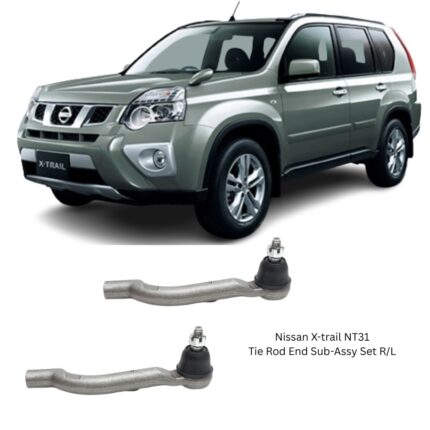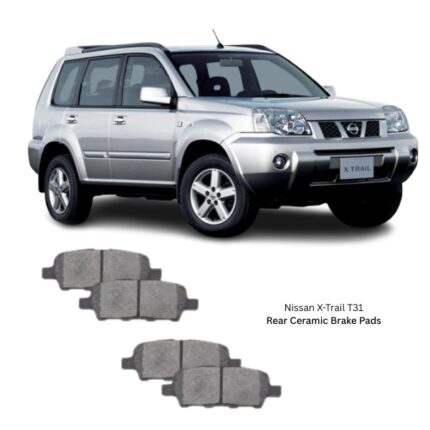Get Nissan X-trail T31 Rear Ceramic Brake Pads D1244 in Kenya
Rear ceramic brake pads are advanced friction components designed to provide reliable braking performance, extended durability, and a smoother, quieter ride. Used primarily in passenger vehicles, sedans, SUVs, and light trucks, ceramic brake pads are favored for their exceptional balance of performance, comfort, and longevity. Installed on the rear axle of a vehicle, these pads work in conjunction with the rear brake rotors to safely bring the vehicle to a halt, especially during everyday driving conditions.
While they may appear as small, flat, rectangular components with a hard surface, ceramic brake pads are carefully engineered from a blend of modern materials to meet the evolving needs of modern vehicles. This in-depth explanation highlights their construction, performance characteristics, installation considerations, benefits, limitations, and impact on vehicle safety.
1. Function of Rear Brake Pads
Brake pads are crucial to the disc braking system, which uses friction to slow down or stop the rotation of a vehicle’s wheels. The rear brake pads are mounted inside the rear calipers and press against the rotating rear brake rotors when the brake pedal is applied. This contact creates the friction necessary to reduce the wheel’s rotational speed, ultimately stopping the vehicle.
Although front brakes typically handle more braking force due to weight transfer, the rear brake pads play a vital role in stabilizing the vehicle under braking, helping maintain balance, prevent oversteer, and support systems like ABS and traction control.
2. Composition of Ceramic Brake Pads
Ceramic brake pads are made from a dense compound of ceramic fibers, nonferrous metal particles (such as copper), bonding agents, and filler materials. The ceramic used is similar to that found in pottery but is significantly more heat-resistant and durable. Key components include:
-
Fine ceramic fibers: Provide structural strength and thermal stability.
-
Copper or brass fibers: Enhance heat transfer and help remove debris.
-
Bonding resins: Bind the material into a solid, cohesive structure.
-
Friction modifiers: Improve grip and wear behavior.
This composition results in a lightweight pad that maintains consistent braking performance across a wide range of temperatures and conditions.
3. Performance Characteristics
Ceramic brake pads are engineered to deliver predictable, linear braking power, which is especially important in rear braking, where excessive grip or lockup could cause instability. Their performance features include:
-
Low noise output: Ceramic pads produce minimal squeal due to their density and vibration-dampening qualities.
-
Low dust generation: They create fine, light-colored brake dust that doesn’t stick to wheels or accumulate excessively.
-
Stable friction levels: They deliver consistent braking performance at both low and high temperatures, reducing brake fade.
-
Long lifespan: Ceramic pads are generally longer-lasting than organic or semi-metallic pads under normal driving conditions.
4. Advantages of Rear Ceramic Brake Pads
Ceramic brake pads offer a suite of benefits that make them ideal for rear braking applications in many vehicles:
a) Quieter Operation
The hard, stable compound produces less vibration and resonant noise, resulting in whisper-quiet braking compared to semi-metallic or organic pads.
b) Cleaner Wheels
Ceramic pads generate very little dust, and what they do produce is lighter and less noticeable. This helps maintain a cleaner wheel appearance, especially on alloy wheels.
c) Enhanced Comfort
Drivers often report smoother pedal feel and more progressive braking action with ceramic pads, especially in stop-and-go traffic or urban driving.
d) Thermal Efficiency
Ceramic pads perform well under moderate to high temperatures, resisting fade even with prolonged use during daily commuting or highway driving.
e) Low Rotor Wear
The composition is generally more rotor-friendly, reducing scoring and extending the rotor’s service life.
5. Limitations of Ceramic Brake Pads
Despite their many benefits, ceramic brake pads are not suited for all applications. Some limitations include:
a) Cost
Ceramic brake pads tend to be more expensive than semi-metallic or organic alternatives due to the complex materials and manufacturing process.
b) Lower Initial Bite
Compared to semi-metallic pads, ceramics may feel less aggressive at the start of braking, especially in emergency situations or when the pads are cold.
c) Not Ideal for Heavy-Duty Applications
In high-performance, racing, or towing environments where braking systems experience extreme heat and repeated high-load stops, ceramic pads may lack the necessary aggressiveness and heat management.
6. Rear Axle Braking Dynamics
Rear brakes, while responsible for less braking force than front brakes, are essential for braking balance and vehicle control. Ceramic pads on the rear axle ensure:
-
Even heat distribution, especially important during long downhill descents.
-
Stable stopping behavior, reducing rear-end instability.
-
Compatibility with ABS, electronic brake-force distribution (EBD), and other stability systems that rely on precise rear-wheel braking inputs.
Using ceramic brake pads at the rear often complements ceramic or hybrid pads at the front, ensuring a consistent feel throughout the system.
7. Installation Considerations
Proper installation of rear ceramic brake pads ensures optimal performance and lifespan. Basic steps include:
-
Lifting and securing the vehicle, followed by wheel removal.
-
Removing the caliper and old pads, inspecting rotors for wear.
-
Cleaning the caliper bracket and hardware, applying brake grease where appropriate.
-
Installing the new ceramic pads, ensuring proper alignment with shims and hardware.
-
Reassembling the caliper, torquing bolts to manufacturer specifications.
-
Bed-in (burnishing) process, involving controlled stops to seat the pads properly against the rotors.
A proper break-in process ensures uniform pad wear and optimal contact area.
8. Maintenance and Lifespan
Ceramic brake pads are relatively low-maintenance but should still be checked periodically. Maintenance tips include:
-
Inspecting pad thickness during routine service intervals.
-
Monitoring braking performance, such as noise or vibration.
-
Checking rotor condition, as even ceramic-friendly pads can wear rotors over time.
-
Re-lubricating hardware, especially caliper slides and abutment points.
Ceramic pads generally last 50,000 to 100,000 kilometers, depending on driving habits and environmental conditions.
9. Environmental and Safety Aspects
Ceramic brake pads are considered more environmentally friendly due to:
-
Low copper formulations (modern standards limit copper due to water contamination risks).
-
Less airborne dust, reducing pollutant release.
-
Longer service life, meaning fewer replacements and less waste.
In terms of safety, their predictable performance, resistance to fade, and quiet operation make ceramic brake pads a top choice for modern vehicles focused on comfort and control.
10. Applications and Compatibility
Ceramic rear brake pads are best suited for:
-
Daily commuters
-
Family vehicles
-
Urban and suburban driving environments
-
Drivers prioritizing low noise and cleanliness
-
Vehicles with alloy wheels prone to visible brake dust
They are available in various shapes and sizes, specific to caliper and rotor configurations, and should always be matched according to the vehicle manufacturer’s specifications.
Follow us on Facebook for more parts.




